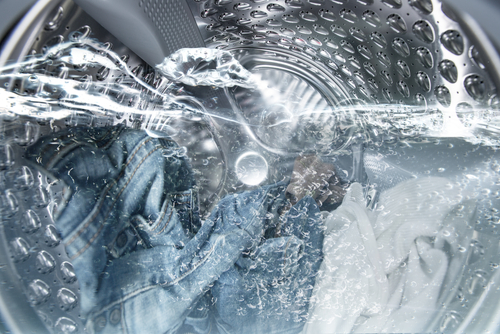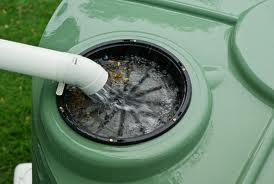Install a Greywater System
The average American uses 70 or more gallons of water every day indoors. Some of this water is reusable and perfect for watering outdoors! The solution? A “greywater” system. Let your socks help keep your garden green!
Your Impact
Action Steps & Tips
Introduction

One of the simplest ways to save water is to reuse “gently” used water from your home to water your garden or flush your toilet. Called greywater, this is lightly used water from your shower or washing machine that is clean enough to reuse in your garden. While greywater is not safe for drinking or cooking, it is great for your plants!
Using greywater can be as simple as placing a bucket in your shower to catch water to flush your toilet, or a more automated set up that brings the water from your laundry or shower directly to your garden. More complicated systems include filters and pumps and can tie into drip irrigation systems.
Simple greywater systems are relatively easy to set up and can create a good steady water source for your plants. This is especially helpful in areas experiencing drought. Greywater systems are a great way to make the most of our precious water resources!
Greywater systems:
-
Are easy to install
-
Save money and precious water resources
1Choose your greywater system
Greywater systems go from very easy to more complicated. Learn more below and choose the right option for you.
A bucket in the shower. The simplest way to start collecting greywater is using a bucket in the shower. Collect the cold water that runs in the shower before the water heats up. This water can be used to flush toilets or water plants in your home or yard. You can also collect water from the bathroom or kitchen sink while waiting for the water to heat up.
Did you know up to 30% of indoor household water is used for flushing toilets? This is a great use for greywater! Simply pour the greywater into the toilet bowl at a good speed until a “flush” occurs automatically (without using the flush handle). Greywater should not be put directly into the toilet tank, as residue from soaps can corrode the parts inside.
Laundry to landscape. The next option is bringing water from your laundry to your garden. This is the easiest system to set up and makes a great do it yourself project! Just route the hose from your washing machine where water is drained to either a barrel or a system of hoses that bring the water to your garden. The internal pump from the washing machine automatically pushes the water out, without the need for an extra pump. Each load of laundry creates from 10 to 40 gallons of water depending on your washing machine.
Shower to landscape. A bit more complicated greywater system connects your shower to your garden. This requires a bit more plumbing and also often requires a pump to deliver the water. Check out more information on a basic greywater system. Simple systems cost around $100 for parts. If you plan to install this type of system or one that ties into drip irrigation systems, you may benefit from hiring a professional.
2 Install your system and start watering!
Follow the guidelines for a basic greywater system, install your system and start watering! Then, follow these tips on gardening with greywater:
How to make the best use of greywater in the garden. Water larger plants like trees, bushes, shrubs, and large annuals with your greywater. It is more difficult to water lots of small plants over a large area. Make sure to match the water amounts being provided to your plants' needs. If you use greywater for plants that produce food, it is important to keep the greywater on only the roots of the plants and not any parts that will be eaten. Greywater should be used within 24 hours.
Keep your greywater safe for plants. Use safe soaps and detergents in your home so you don’t harm your plants. It’s also a good practice in general for all water uses! Avoid harsh chemicals like chlorine bleach and borax or salts. Look for soap products labeled “biodegradable” or “biocompatible”.
Congrats! You’ve completed another important water-wise action!

